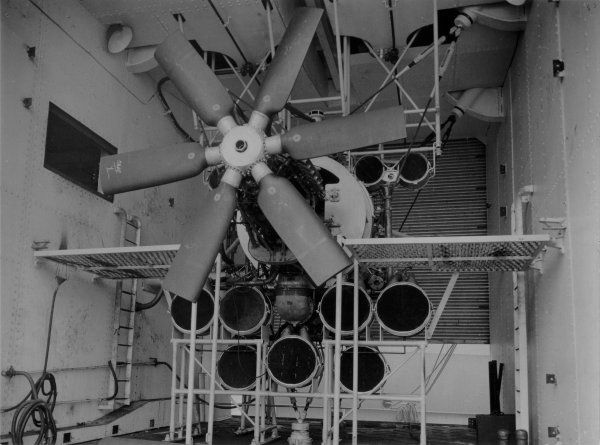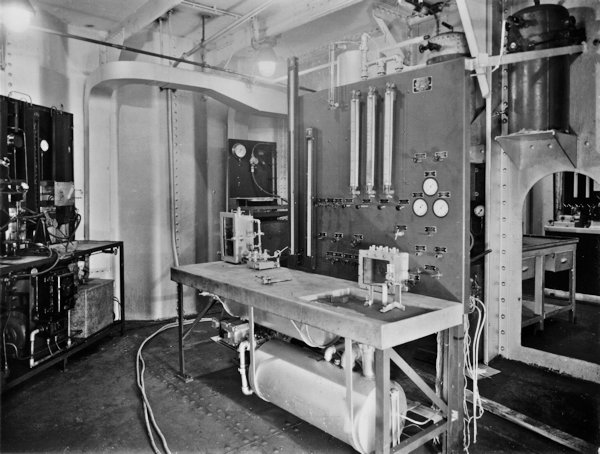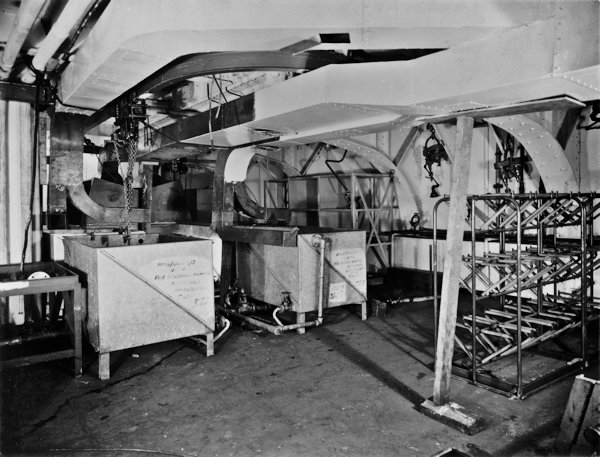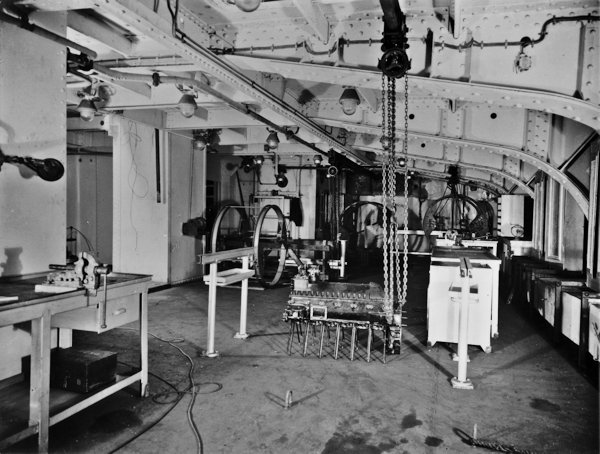Aircraft Engine Repair Ship

Battle Honours
None
Specifications
Builder: Redhead & Sons Ltd. South Shields, United Kingdom
Displacement: 6,924 tons
Length: 431 ft
Beam: 56 ft
Draught: 26 ft 6 in
Speed: 11 Knots
Crew complement: ?
Commanding Officers
Capt. Joseph John Youngs, DSC, OBE, RD, RNR 11 Jun 1945 - mid 1946
Related items
None
Reminiscences
None
Gallery
None
H.M.S. BEAULY FIRTH
.jpg)
Photo: © IWM (FL 1703)
Early history
Laid down as the ‘C’ type cargo vessel EMPIRE SARAWAK for the Ministry of War Transport on December 17th 1943 at the Redhead & Sons Ltd. Shipyard South Shields, England, Yard Number 547, she was launched on August 24th 1944.
Subsequently requisitioned by the Admiralty for conversion into the first of three Aircraft Engine Repair Ships. She was one of five 'Moray Firth' class repair ships building in British yards1 (BEAULY FIRTH, CUILLIN SOUND, HOLM SOUND, MORAY FIRTH and SOLWAY FIRTH) that were planned as Aviation Repair Ships for deployment with the Fleet Train of British Pacific Fleet (BPF).
After her launch the EMPIRE SARAWAK went up the river Tyne to the yard of Palmers and Co. at Hebburn for completion. This work included her being outfitted with general, and specialist aircraft workshops and engine test bays2. On completion EMPIRE SARAWAK was renamed as HMS ‘BEAULY FIRTH' after a stretch of water near Inverness, and commissioned June 10th 1945.
Allocated to the British Pacific Fleet
After completing her sea trials she went to Rosyth to load stores and ammunition before she received her sailing orders. By this time the war was over and she was initially ordered to sail for Hong Kong but these orders were cancelled before she sailed and new orders were received to proceed to Singapore. After passing through the Suez Canal BEAULY FIRTH called at Aden to take on fuel and fresh water before continuing on to Flores Island, Indonesia, for a short stop over, before reaching Singapore on December 9th. She sailed for Australia on December 10th, crossed the line on 11th December and called in at Flores again on the15th. She arrived in Townsville, Queensland, Australia on December 23rd 1945, where leave was granted over the Christmas period, many members of the ships’ company being hosted by local families.
In the New Year work continued repairing aero engines; transporting the engines and stores was done using two large lighters, similar to landing craft, which were carried on board. Engines passed through the various workshops before being test run in one of the two, hangar like, athwartships test bays on the aft of the ship. When testing engines the ship had to move to a remote anchorage to run them up to full power; this was a very noisy job so it had to be done away from populated areas, also the force of the thrust generated by the test propellers coming out of the fully open test bay were sufficient to drive the ship in a circle around her anchor or to veer off course if attempted underway. While operating off Bunderberg, Queensland, one lighter was caught in rough weather and lost an engine; her coxswain (also the ships’ diver) attempted to recover her but was stranded overnight on a deserted beach when the second engine failed. He was rescued once the weather improved.
Food for Britain Ship
Early in February HMS BEAULY FIRTH was ordered to cease repair operations and to ‘clean ship’ in preparation for operation as a cargo vessel – lend lease materials and excess equipment including engines, spares and workshop equipment were dumped at sea off the Great Barrier Reef prior to the ship proceeding to Brisbane. She arrived at New Farm Wharf, Brisbane on Friday February 15th 1946, later than planned., She was supposed to reach Fremantle from Brisbane on Sunday 17 February 1946, but instead entered the Cairncross graving dock for repairs. On un-docking on February 19th she began loading 740 tons of food, (20,000 cases worth £30,000) from the Lord Mayor's ‘Food for Britain Appeal’3. From Brisbane next port of call was Sydney, arriving there late afternoon on Saturday March 2nd. After loading more stores she sailed from no.14 berth Pyrmont, Sydney for Fremantle via Melbourne on Tuesday March 5th.
HMS BEAULY FIRTH docked at Fremantle on Tuesday March 19th where she was to embark more cargo, this time under heavy security as a quantity of Gold Bullion was taken aboard. A consignment of 25 tons of stores for delivery to the Cables, and Wireless staff, Cocos Island, and fresh provisions for the naval ratings stationed there were also embarked. She sailed for the U.K. on March 20th calling at Cocos Islands, Aden, arriving in Cardiff on May 27th. On arrival in Cardiff the 20,000 cases of Food, gifted by the people of Queensland, was distributed to the aged and needy of Cardiff. Once this task was completed HMS BEAULY FIRTH proceeded to Rosyth and was paid off.
Disposal
In 1948 she was purchased from the Admiralty by the Stanhope Steamship Co Ltd and converted for commercial use and renamed STANFIRTH. Operated under the management of J A Billmeier & Co Ltd. Until she was sold in 1961 to Compagnia Navigazione y de Comercio Degedo Ltda, Costa Rica, renamed AKAMAS and operated under the management of Aegis Shipping Co Ltd, Greece. Further Sold on in 1966 to Akamas Shipping Co Ltd, Cyprus, remaining under Aegis's management. Renamed SKEPSIS in 1968, but arrived at Shanghai for scrapping on 23 August 1968.
HMS BEAULY FIRTH at Fremantle,
March 9th 1946
Photo:
State library of Victoria/a>
H91.250/1382 & H91.250/1383
Various ship departments
Thes images below are of the interior of HMS MORAY FIRTH; all three ships of this type were identical in layout, but equipment differed for supported engine types Click an image to enlarge it.
These images are of HMS. MORAY FIRTH and are from the collection of David Nairn who served on the ship as a Sub-Lieut (A) R.N.V.R. The images are supplied by his daughter and son-in-law, Margaret Nairn and John Struthers. Further HMS Moray Firth images can be found at bit.ly/hmsmorayfirth
Notes:
1. BEAULY FIRTH was an Aircraft Engine Repair Ship, although some commentators list her as a Hull Repair ship, which most of the 'Moray Firth' class were.
2. Records are sketchy for the six Aviation Repair Ships built for the Fleet Air Arm, however there ware two distinct types – Component repair, and Engine Repair. It is highly probable that these ships specialised in either British or American types. What evidence exists suggests the following assignments:
Deer Sound = Component*
Holm Sound = Component* British airframes and component types
Cuillin Sound = Component
Beauly Firth = Engine* - British in-line Engines
Moray Firth = Engine* - British in-line Engines
Solway Firth = Engine* - American Radial engines?
*See AFO 7521/45 —Complement Amendments (N/G.013545/45.—27 Dec. 1945.) which states:
H.M. Ships “Beauly Firth” , “Moray Firth” and “Solway Firth” as Aircraft Engine Repair Ships (Admiralty Letter N.15743/44 of 5 July, 1944).
H.M.S. “Deer Sound” as Aircraft Component Repair Ship (Admiralty Letter N .29837/43 of 7 March, 1944).
H.M.S. “Holm Sound” as Aircraft Component Repair Ship (Admiralty Letter N .32706/44 of 8 January 1945).
3. Originally an appeal made by the Lord Mayor of Melbourne in September 1945 to send food to Britain in Mercy Food Shipments. The appeal became nation-wide but was still called the Lord Mayor's Food for Britain appeal.
Last modified: 23 February 2023
Primary information sources
Additional sources:
Kinnear, Les (IWM interview) Audio recording Reel 11
www.iwm.org.uk/collections/item/object/80023606
Accessed 18 May 2015
Hutchinson, Frederick George (IWM interview) Audio recording Reel 3
www.iwm.org.uk/collections/item/object/80010665
Accessed 18 May 2015
The wartime diary of the late Jack Mills, extracts courtesy of his Daughter
Valerie .























Comments (11)
My Father, Philip Davies sailed to Australia on this ship aged 20 as a rating. He too described staying on a family farm and how generous the people of Australia were in sending food to the UK. In addition to dumping equipment to make room for stores, he also recalled dumping machine tools in St Georges Channel as it was felt that surplus tools would hold back economic recovery in the UK.
My father, CPO Jack Martin (Air Mechanic E) sailed in HMS Beauly Firth to Australia and back 1945-6, during which period I was born. He enlisted in 1936, and retired from the RN in 1963 as a Lieutenant. He was likely acquainted with some of those mentioned below who served on the ship at that time. Whilst in Australia, he visited relatives, with whom he lost all contact and we know nothing about. Would anyone know who they were ?
We would appreciate any stories, records or photographs that anyone would like to share